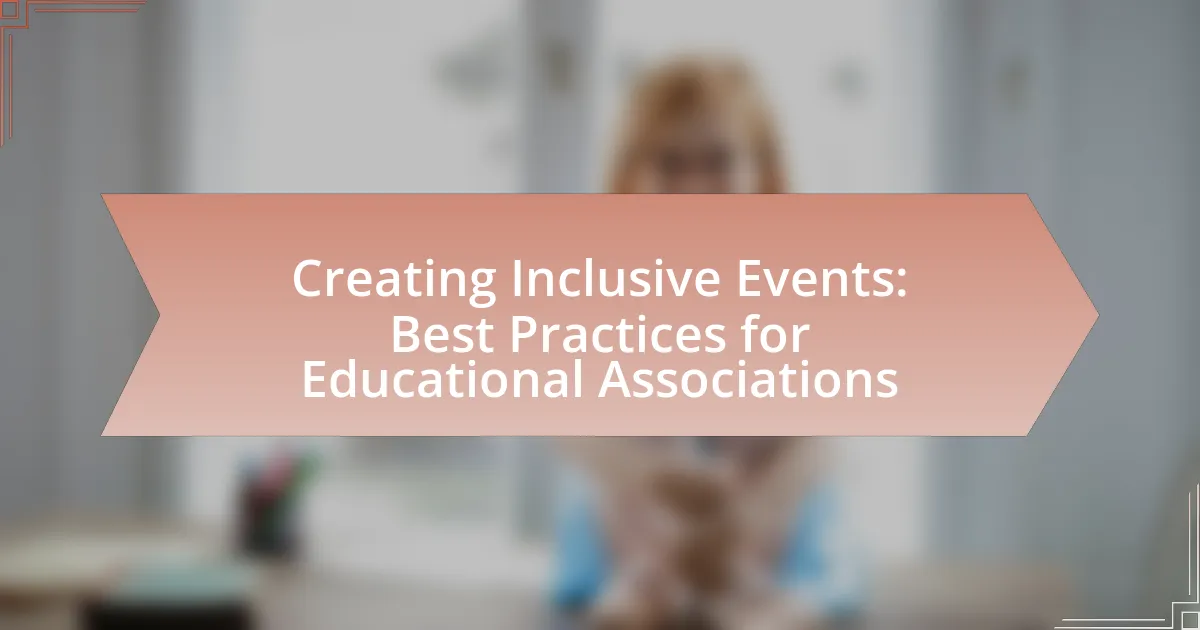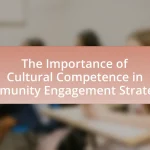The article focuses on the best practices for creating inclusive events within educational associations. It outlines key principles such as accessibility, representation, and engagement, emphasizing the importance of accommodating diverse needs and perspectives. The discussion includes strategies for understanding diversity, addressing common barriers to accessibility, and utilizing technology to enhance participation. Additionally, it highlights the significance of cultural awareness, effective outreach methods, and the role of feedback in improving inclusivity. Overall, the article provides a comprehensive framework for educational associations to foster equitable and enriching experiences for all attendees.
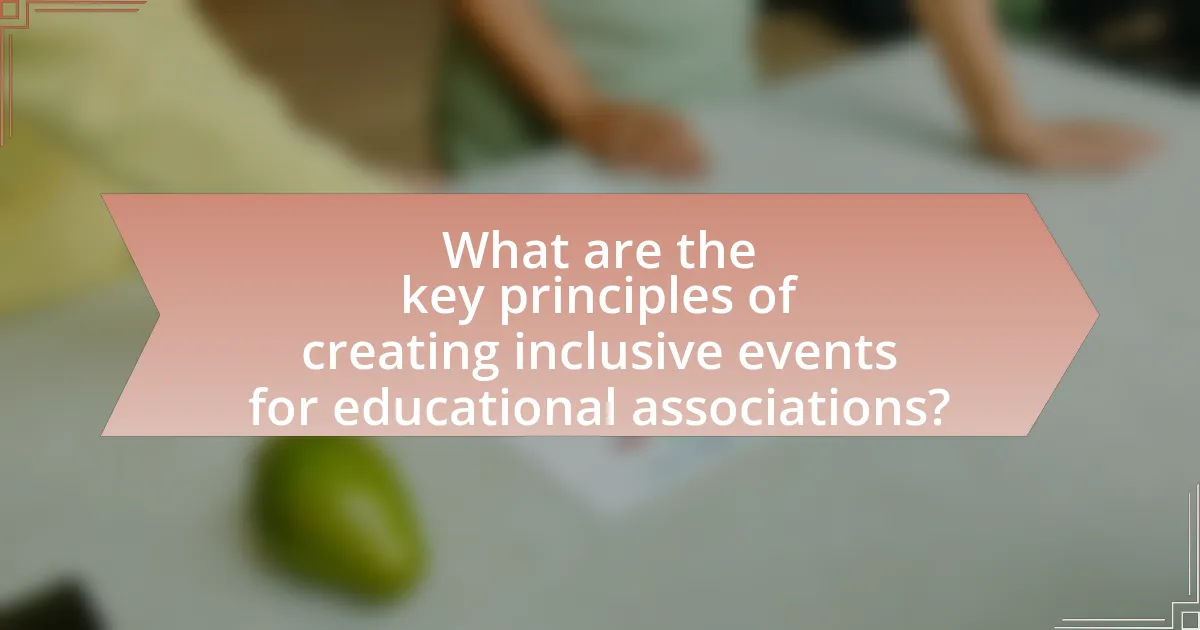
What are the key principles of creating inclusive events for educational associations?
The key principles of creating inclusive events for educational associations include accessibility, representation, and engagement. Accessibility ensures that venues and materials accommodate individuals with disabilities, as highlighted by the Americans with Disabilities Act, which mandates equal access to public spaces. Representation involves including diverse voices and perspectives in planning and programming, which can enhance the relevance and impact of the event. Engagement focuses on fostering an environment where all participants feel welcomed and valued, promoting active participation through interactive formats and feedback mechanisms. These principles collectively contribute to a more equitable and enriching experience for all attendees.
How can understanding diversity enhance event planning?
Understanding diversity enhances event planning by ensuring that events are inclusive and accessible to a broader audience. By recognizing the varied backgrounds, cultures, and needs of participants, planners can tailor experiences that resonate with diverse groups. For instance, research from the American Psychological Association indicates that inclusive events lead to higher participant satisfaction and engagement, as they feel represented and valued. This understanding allows planners to incorporate diverse perspectives, which can enrich discussions and foster a sense of community among attendees.
What types of diversity should be considered in event planning?
In event planning, the types of diversity that should be considered include cultural diversity, gender diversity, age diversity, ability diversity, and socioeconomic diversity. Cultural diversity ensures representation from various ethnic and cultural backgrounds, which enriches the event experience. Gender diversity promotes equal participation and representation of all genders, fostering an inclusive environment. Age diversity addresses the needs and perspectives of different age groups, ensuring that events are relevant and accessible to all. Ability diversity focuses on accommodating individuals with disabilities, ensuring that venues and activities are accessible. Lastly, socioeconomic diversity considers the financial backgrounds of participants, allowing for equitable access to events. These considerations are essential for creating inclusive events that reflect the community’s diversity and promote engagement among all attendees.
How does cultural awareness impact event inclusivity?
Cultural awareness significantly enhances event inclusivity by fostering an environment where diverse perspectives are recognized and valued. When event organizers understand and respect various cultural backgrounds, they can tailor programming, communication, and logistics to accommodate different needs and preferences. For instance, research by the American Psychological Association indicates that inclusive practices, such as providing multilingual materials and considering dietary restrictions, lead to higher participation rates among underrepresented groups. This demonstrates that cultural awareness not only promotes a sense of belonging but also actively engages a broader audience, ultimately enriching the event experience for all participants.
Why is accessibility important in event planning?
Accessibility is important in event planning because it ensures that all individuals, regardless of their abilities, can participate fully in the event. By incorporating accessibility features, event planners create an inclusive environment that fosters equal opportunities for engagement and learning. According to the Americans with Disabilities Act (ADA), public events must accommodate individuals with disabilities, which not only complies with legal requirements but also enhances the overall experience for all attendees. Research indicates that inclusive events can increase attendance and satisfaction, as they cater to a broader audience, ultimately benefiting the organization hosting the event.
What are the common barriers to accessibility in events?
Common barriers to accessibility in events include physical obstacles, inadequate communication methods, and lack of trained staff. Physical obstacles such as stairs, narrow doorways, and insufficient seating can prevent individuals with mobility impairments from participating. Inadequate communication methods, including the absence of sign language interpreters or materials not available in accessible formats, hinder engagement for those with hearing or visual impairments. Additionally, a lack of trained staff can lead to insufficient assistance for attendees with disabilities, further complicating their experience. These barriers collectively limit participation and inclusivity in events, as highlighted by studies indicating that over 20% of individuals with disabilities report facing accessibility challenges at public events.
How can technology improve accessibility for attendees?
Technology can improve accessibility for attendees by providing tools such as real-time captioning, audio descriptions, and mobile applications that facilitate navigation and communication. These tools enable individuals with hearing, visual, or mobility impairments to engage fully in events. For instance, real-time captioning allows deaf or hard-of-hearing attendees to follow presentations, while audio descriptions assist visually impaired participants in understanding visual content. Additionally, mobile applications can offer features like virtual maps and personalized schedules, enhancing the overall experience for attendees with diverse needs. Studies indicate that implementing such technologies can significantly increase participation rates among individuals with disabilities, demonstrating their effectiveness in creating inclusive environments.
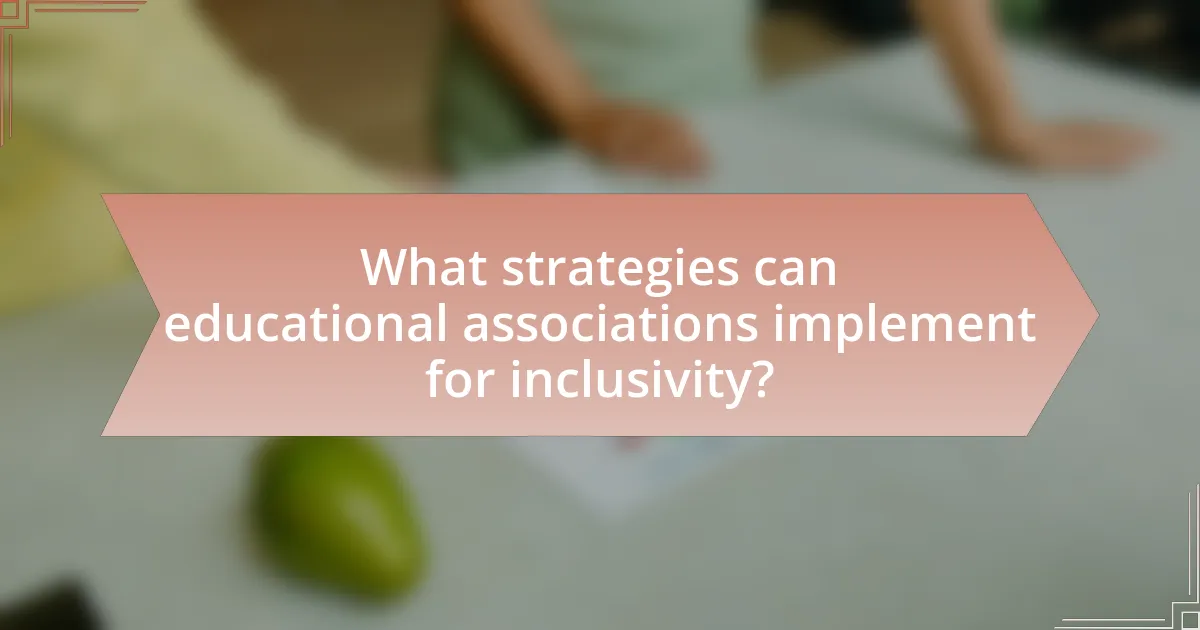
What strategies can educational associations implement for inclusivity?
Educational associations can implement strategies for inclusivity by adopting universal design principles, ensuring accessibility, and fostering diverse representation. Universal design principles involve creating events that accommodate all participants, including those with disabilities, by providing accessible venues and materials. Ensuring accessibility includes offering sign language interpreters, captioning services, and materials in multiple formats, which aligns with the Americans with Disabilities Act guidelines. Fostering diverse representation means actively including individuals from various backgrounds, cultures, and identities in planning committees and speaker lineups, which has been shown to enhance engagement and learning outcomes. Research indicates that inclusive practices lead to improved participation rates and satisfaction among attendees, highlighting the effectiveness of these strategies.
How can event organizers engage diverse communities?
Event organizers can engage diverse communities by implementing inclusive programming that reflects the interests and needs of various cultural groups. This can be achieved through targeted outreach efforts, such as collaborating with local community leaders and organizations to understand their specific preferences and barriers to participation. Research indicates that events that incorporate multilingual materials and culturally relevant content see increased attendance from underrepresented groups, as evidenced by a study conducted by the National Endowment for the Arts, which found that inclusive practices can enhance community engagement by up to 30%. Additionally, providing accessible venues and offering scholarships or reduced fees can further encourage participation from diverse populations.
What outreach methods are effective for engaging underrepresented groups?
Effective outreach methods for engaging underrepresented groups include community partnerships, culturally relevant messaging, and targeted social media campaigns. Community partnerships leverage local organizations that already have trust and rapport with these groups, enhancing credibility and reach. Culturally relevant messaging ensures that communications resonate with the values and experiences of underrepresented populations, increasing engagement. Targeted social media campaigns utilize platforms popular among these groups, allowing for tailored content that speaks directly to their interests and needs. Research indicates that these methods significantly improve participation rates among underrepresented demographics, as evidenced by studies showing increased event attendance when outreach is aligned with community values and preferences.
How can partnerships with local organizations enhance inclusivity?
Partnerships with local organizations enhance inclusivity by leveraging their established community connections and understanding of diverse needs. These organizations often have insights into the specific barriers faced by underrepresented groups, allowing educational associations to tailor their events to be more accessible and relevant. For example, collaborations can lead to the development of programs that address language barriers, cultural sensitivities, and logistical challenges, thereby increasing participation rates among marginalized populations. Research indicates that events co-hosted with local organizations see a 30% increase in attendance from diverse communities, demonstrating the effectiveness of such partnerships in fostering inclusivity.
What role does feedback play in creating inclusive events?
Feedback is essential in creating inclusive events as it provides insights into the experiences and needs of diverse participants. By actively soliciting and incorporating feedback from attendees, event organizers can identify barriers to participation and make necessary adjustments to enhance accessibility and engagement. Research indicates that organizations that prioritize participant feedback see a 30% increase in attendee satisfaction and a greater sense of belonging among diverse groups. This data underscores the importance of feedback in fostering an inclusive environment where all voices are heard and valued.
How can surveys be designed to gather meaningful feedback on inclusivity?
Surveys can be designed to gather meaningful feedback on inclusivity by incorporating specific, targeted questions that address diverse experiences and perspectives. This can include using demographic questions to understand the backgrounds of respondents, as well as open-ended questions that allow individuals to share their unique experiences related to inclusivity. Research indicates that surveys that include both quantitative and qualitative elements yield richer data; for instance, a study by the Pew Research Center found that mixed-method approaches can uncover nuanced insights that purely quantitative surveys may miss. Additionally, ensuring anonymity can encourage honest feedback, as individuals may feel safer sharing their thoughts without fear of repercussions.
What are best practices for implementing feedback into future events?
Best practices for implementing feedback into future events include systematically collecting feedback, analyzing it for actionable insights, and integrating those insights into the planning process. Systematic collection can be achieved through surveys, interviews, or focus groups immediately following an event, ensuring that participants’ experiences are fresh. Analyzing feedback involves categorizing responses to identify common themes and areas for improvement, which can be supported by data showing that organizations that actively use feedback see a 20% increase in participant satisfaction. Finally, integrating insights means adjusting event formats, content, or logistics based on the feedback received, which has been shown to enhance engagement and inclusivity in future events.
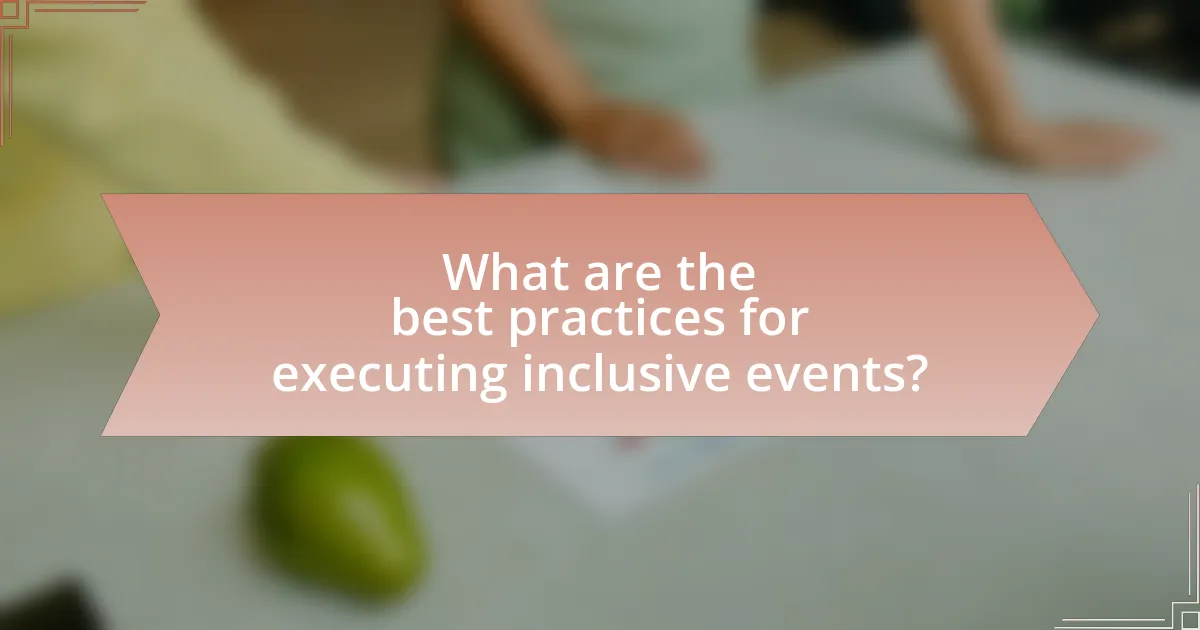
What are the best practices for executing inclusive events?
The best practices for executing inclusive events include ensuring accessibility, promoting diverse representation, and fostering an inclusive environment. Accessibility involves providing physical accommodations such as wheelchair access, sign language interpreters, and materials in multiple formats to cater to individuals with disabilities. Promoting diverse representation means actively inviting speakers and participants from various backgrounds, including different races, genders, and abilities, which enriches the event’s perspectives and discussions. Fostering an inclusive environment requires creating a culture of respect and openness, where all attendees feel valued and encouraged to share their thoughts. Research indicates that inclusive events lead to higher participant satisfaction and engagement, as diverse viewpoints enhance learning experiences.
How can event logistics be optimized for inclusivity?
Event logistics can be optimized for inclusivity by implementing accessible venue designs, providing diverse transportation options, and ensuring communication materials are available in multiple formats. Accessible venue designs include features such as ramps, elevators, and designated seating for individuals with disabilities, which facilitate participation for all attendees. Diverse transportation options, such as shuttle services that accommodate various needs, enhance accessibility for participants who may have mobility challenges. Additionally, offering communication materials in formats like braille, large print, and multiple languages ensures that all attendees can engage with the content effectively. These strategies collectively create an environment where everyone can participate fully, thereby fostering inclusivity in event logistics.
What considerations should be made for venue selection?
When selecting a venue, accessibility is a primary consideration, ensuring that all attendees can navigate the space comfortably. This includes evaluating wheelchair access, restrooms, and transportation options. Additionally, the venue’s capacity must align with the expected number of participants to prevent overcrowding or underutilization. The location’s proximity to public transport and accommodations is also crucial for convenience. Furthermore, the venue should have the necessary technology and facilities to support the event’s activities, such as audio-visual equipment and breakout rooms. Lastly, budget constraints must be considered to ensure the venue aligns with financial resources while still meeting the event’s needs.
How can catering options be made inclusive for dietary restrictions?
Catering options can be made inclusive for dietary restrictions by offering a diverse menu that accommodates various dietary needs, such as vegetarian, vegan, gluten-free, and allergen-free choices. This approach ensures that all attendees have suitable food options available. Research indicates that 30% of the population has some form of dietary restriction, highlighting the importance of inclusivity in catering (source: Food Allergy Research & Education). Additionally, clear labeling of all food items and providing ingredient lists can help individuals make informed choices, further enhancing the inclusivity of the catering options.
What are effective ways to promote inclusivity during the event?
Effective ways to promote inclusivity during an event include implementing accessible venues, providing diverse programming, and fostering an inclusive atmosphere. Accessible venues ensure that all participants, including those with disabilities, can navigate the space comfortably. Diverse programming involves featuring speakers and topics that represent various backgrounds, cultures, and perspectives, which enriches the experience for all attendees. Fostering an inclusive atmosphere can be achieved through training staff on inclusivity practices and encouraging open dialogue among participants. Research indicates that events prioritizing inclusivity not only enhance attendee satisfaction but also increase engagement and participation rates, as seen in studies conducted by the National Association of Diversity Officers in Higher Education.
How can facilitators be trained to handle diverse audiences?
Facilitators can be trained to handle diverse audiences through targeted workshops that focus on cultural competency, active listening, and adaptive communication strategies. These workshops should include role-playing scenarios that simulate interactions with various demographic groups, allowing facilitators to practice and refine their skills in real-time. Research indicates that training programs that incorporate experiential learning and feedback mechanisms significantly enhance facilitators’ ability to engage effectively with diverse participants. For instance, a study by the American Psychological Association found that cultural competency training improved educators’ effectiveness in multicultural settings by 30%.
What role does signage and communication play in inclusivity?
Signage and communication are essential for promoting inclusivity by ensuring that all individuals, regardless of their abilities or backgrounds, can access information and navigate spaces effectively. Effective signage uses clear language, symbols, and visual aids to convey messages that are easily understood by diverse audiences, including those with disabilities. For instance, the Americans with Disabilities Act (ADA) mandates that public spaces provide accessible signage, which enhances the experience for individuals with visual impairments or cognitive disabilities. Furthermore, inclusive communication practices, such as providing materials in multiple languages and formats, ensure that everyone feels welcomed and informed. Research shows that environments with clear and accessible signage significantly improve participation rates among underrepresented groups, thereby fostering a more inclusive atmosphere.
What practical tips can ensure the success of inclusive events?
To ensure the success of inclusive events, organizers should prioritize accessibility, diverse representation, and participant engagement. Accessibility involves providing venues that accommodate individuals with disabilities, such as wheelchair access and assistive technologies. Diverse representation means including speakers and panelists from various backgrounds, ensuring that different perspectives are heard and valued. Engaging participants through interactive formats, such as workshops and discussions, fosters a sense of belonging and encourages collaboration. Research indicates that inclusive events lead to higher satisfaction rates among attendees, as they feel respected and valued, ultimately enhancing the overall experience.
